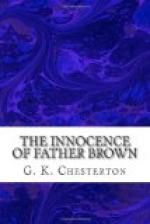They went down the winding stairs in utter silence, and came out into the sunlight by the smithy. Wilfred Bohun carefully unlatched the wooden gate of the yard, and going up to the inspector, said: “I wish to give myself up; I have killed my brother.”
The Eye of Apollo
That singular smoky sparkle, at once a confusion and a transparency, which is the strange secret of the Thames, was changing more and more from its grey to its glittering extreme as the sun climbed to the zenith over Westminster, and two men crossed Westminster Bridge. One man was very tall and the other very short; they might even have been fantastically compared to the arrogant clock-tower of Parliament and the humbler humped shoulders of the Abbey, for the short man was in clerical dress. The official description of the tall man was M. Hercule Flambeau, private detective, and he was going to his new offices in a new pile of flats facing the Abbey entrance. The official description of the short man was the Reverend J. Brown, attached to St. Francis Xavier’s Church, Camberwell, and he was coming from a Camberwell deathbed to see the new offices of his friend.
The building was American in its sky-scraping altitude, and American also in the oiled elaboration of its machinery of telephones and lifts. But it was barely finished and still understaffed; only three tenants had moved in; the office just above Flambeau was occupied, as also was the office just below him; the two floors above that and the three floors below were entirely bare. But the first glance at the new tower of flats caught something much more arresting. Save for a few relics of scaffolding, the one glaring object was erected outside the office just above Flambeau’s. It was an enormous gilt effigy of the human eye, surrounded with rays of gold, and taking up as much room as two or three of the office windows.
“What on earth is that?” asked Father Brown, and stood still. “Oh, a new religion,” said Flambeau, laughing; “one of those new religions that forgive your sins by saying you never had any. Rather like Christian Science, I should think. The fact is that a fellow calling himself Kalon (I don’t know what his name is, except that it can’t be that) has taken the flat just above me. I have two lady typewriters underneath me, and this enthusiastic old humbug on top. He calls himself the New Priest of Apollo, and he worships the sun.”
“Let him look out,” said Father Brown. “The sun was the cruellest of all the gods. But what does that monstrous eye mean?”
“As I understand it, it is a theory of theirs,” answered Flambeau, “that a man can endure anything if his mind is quite steady. Their two great symbols are the sun and the open eye; for they say that if a man were really healthy he could stare at the sun.”
“If a man were really healthy,” said Father Brown, “he would not bother to stare at it.”




